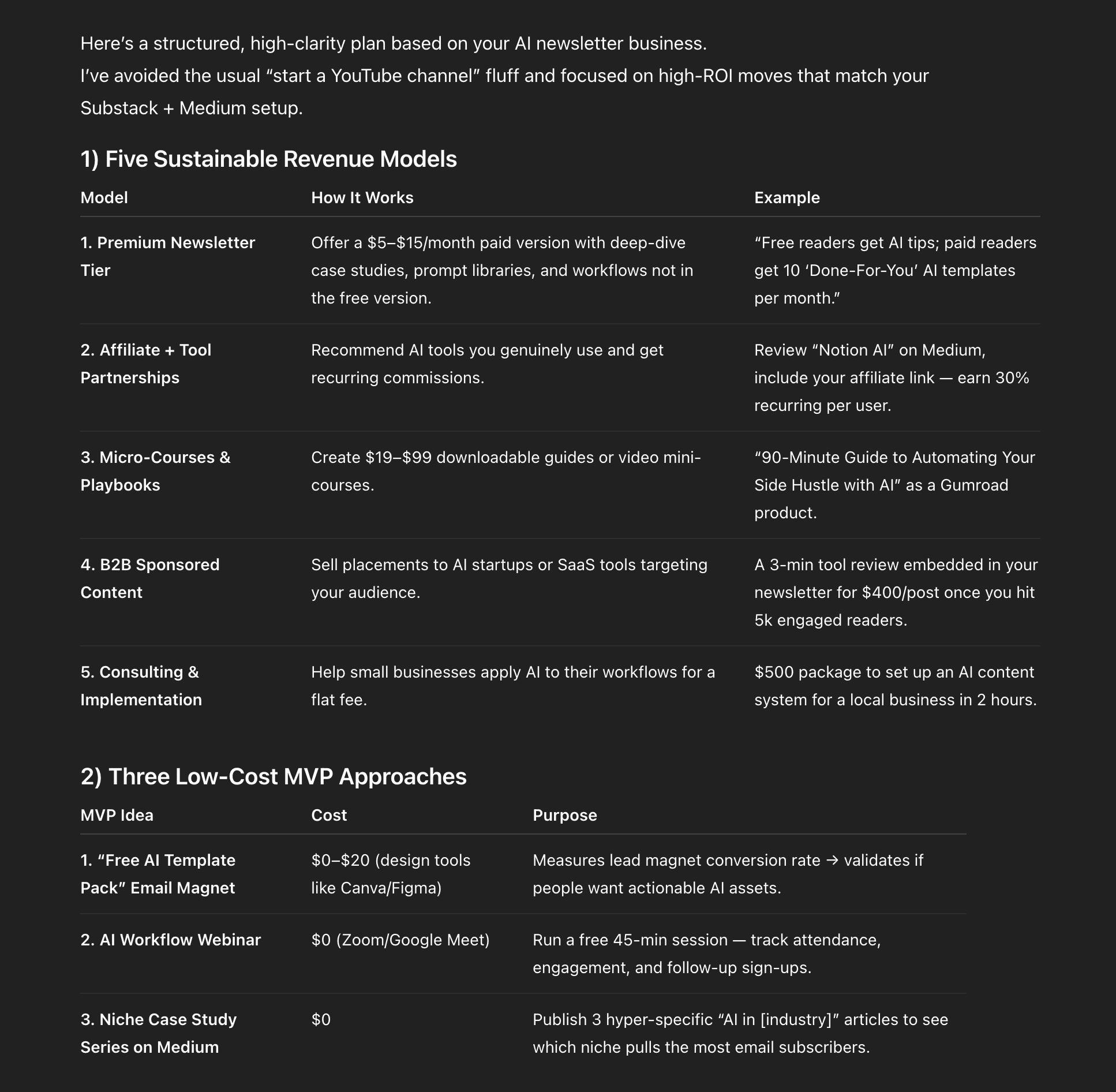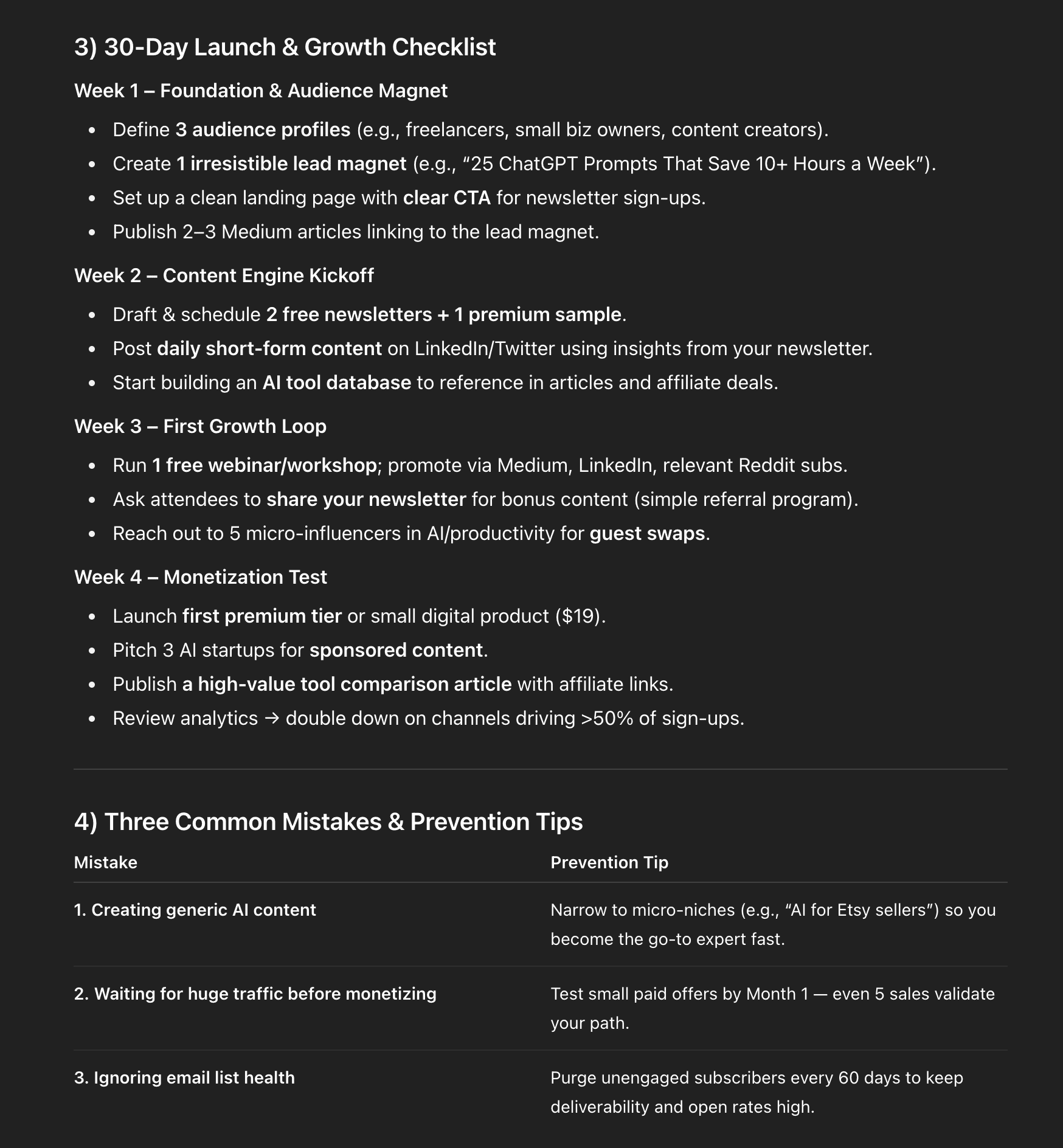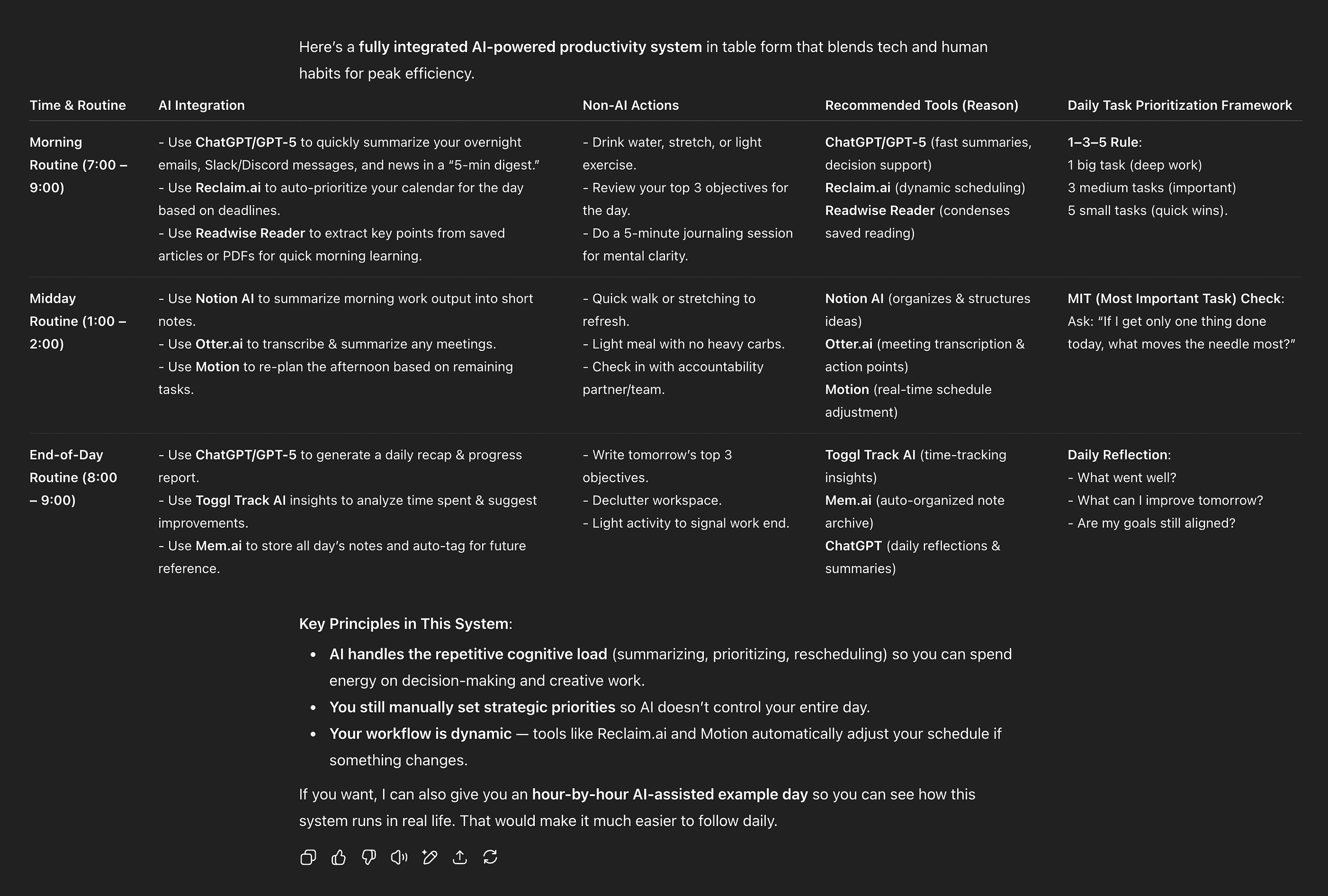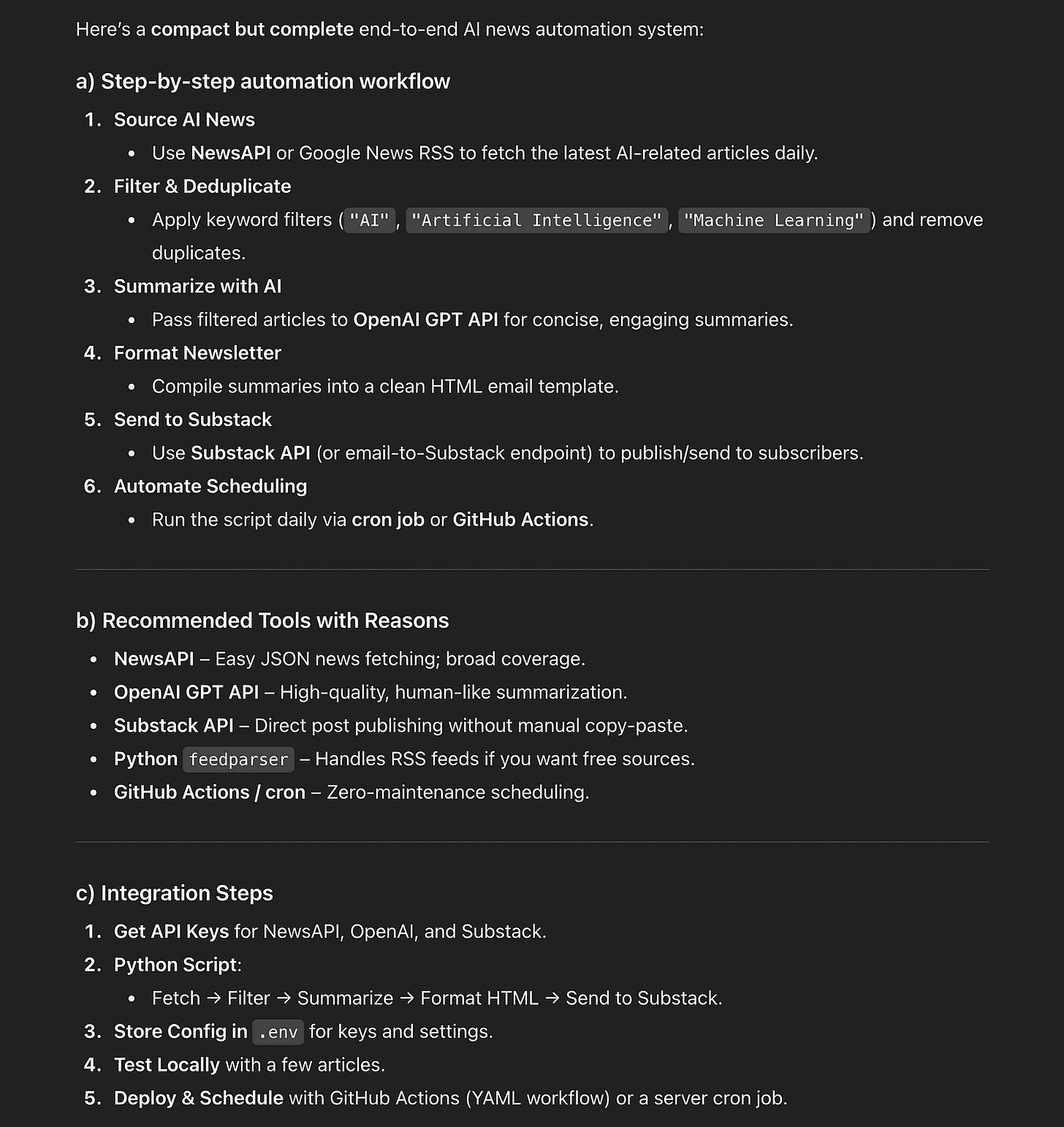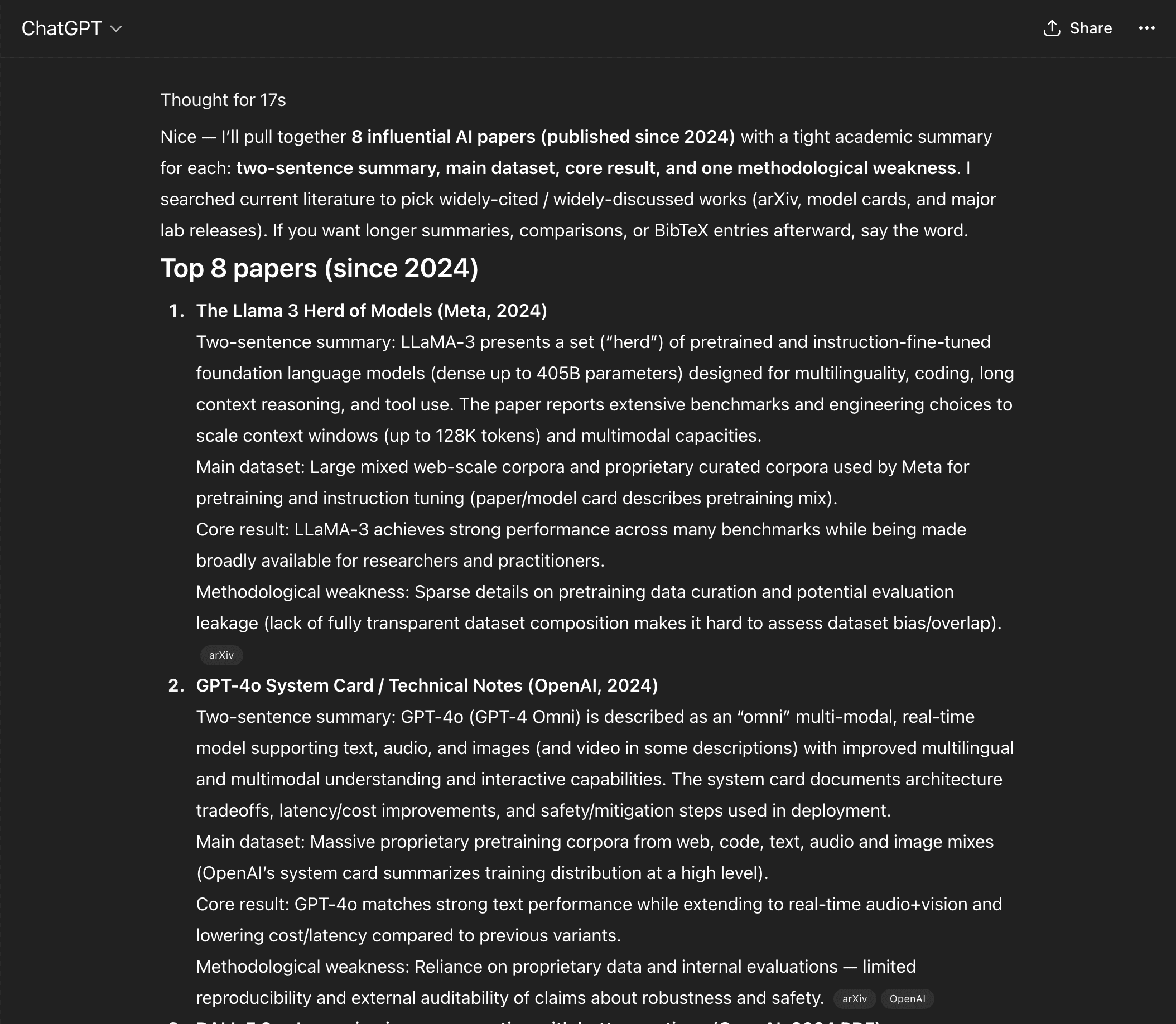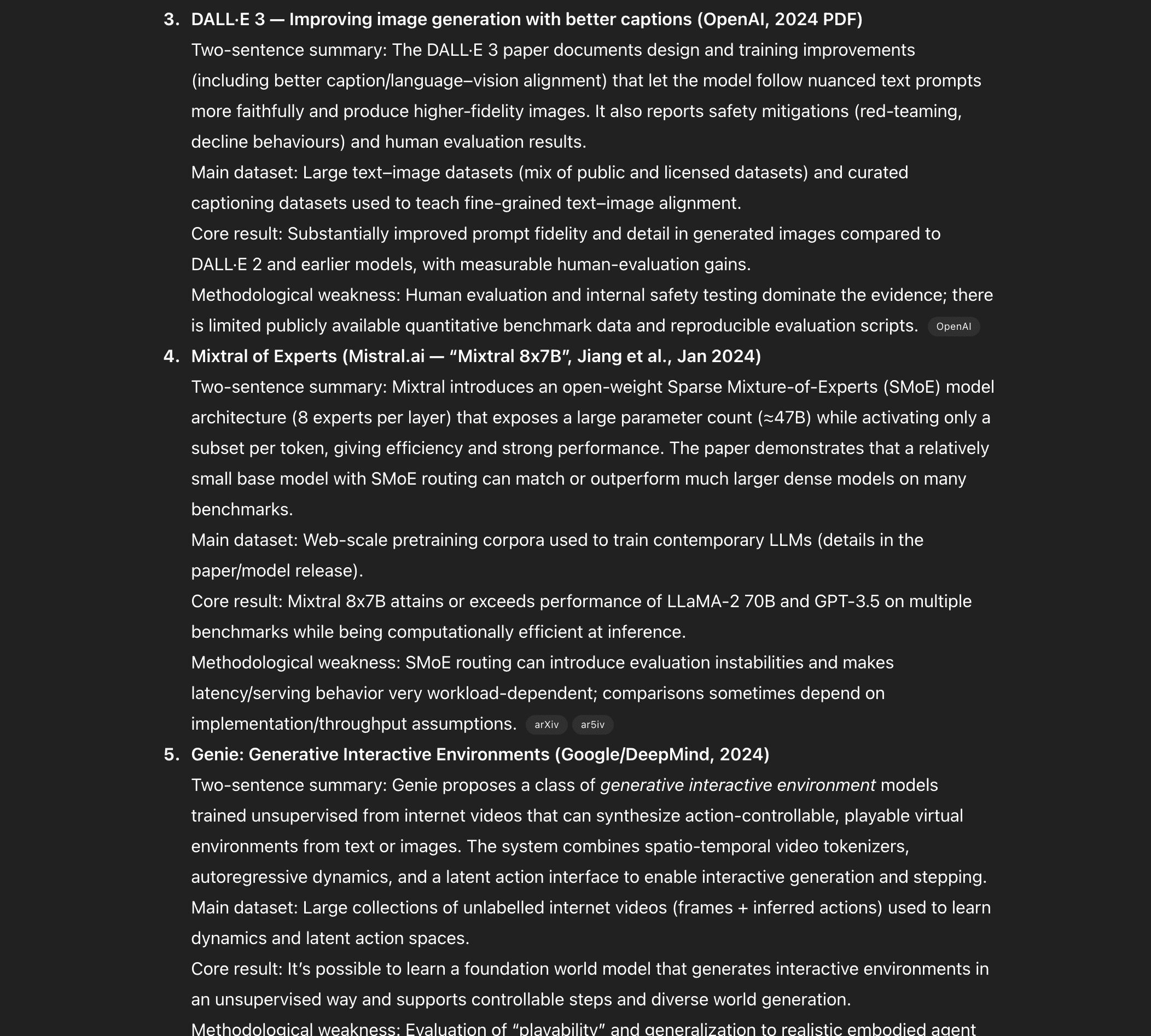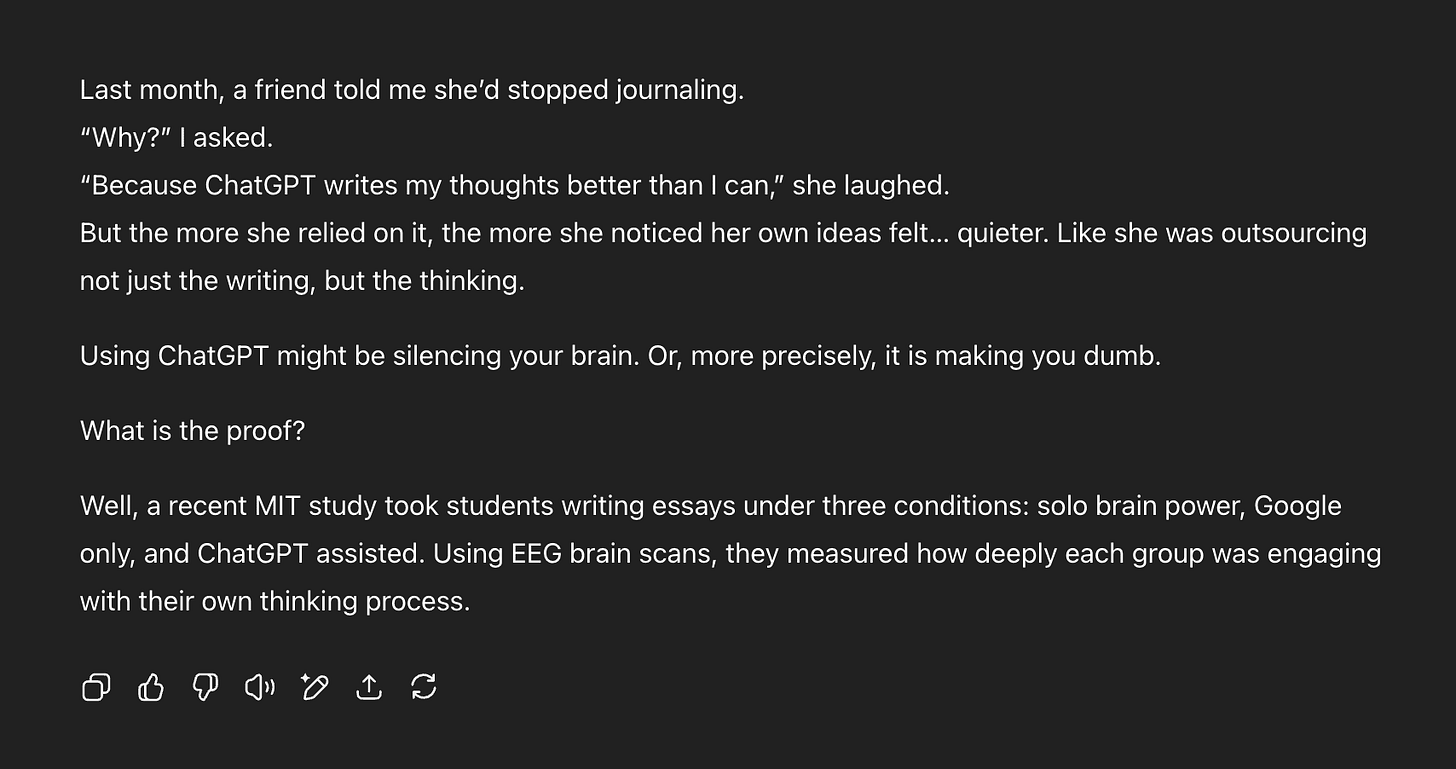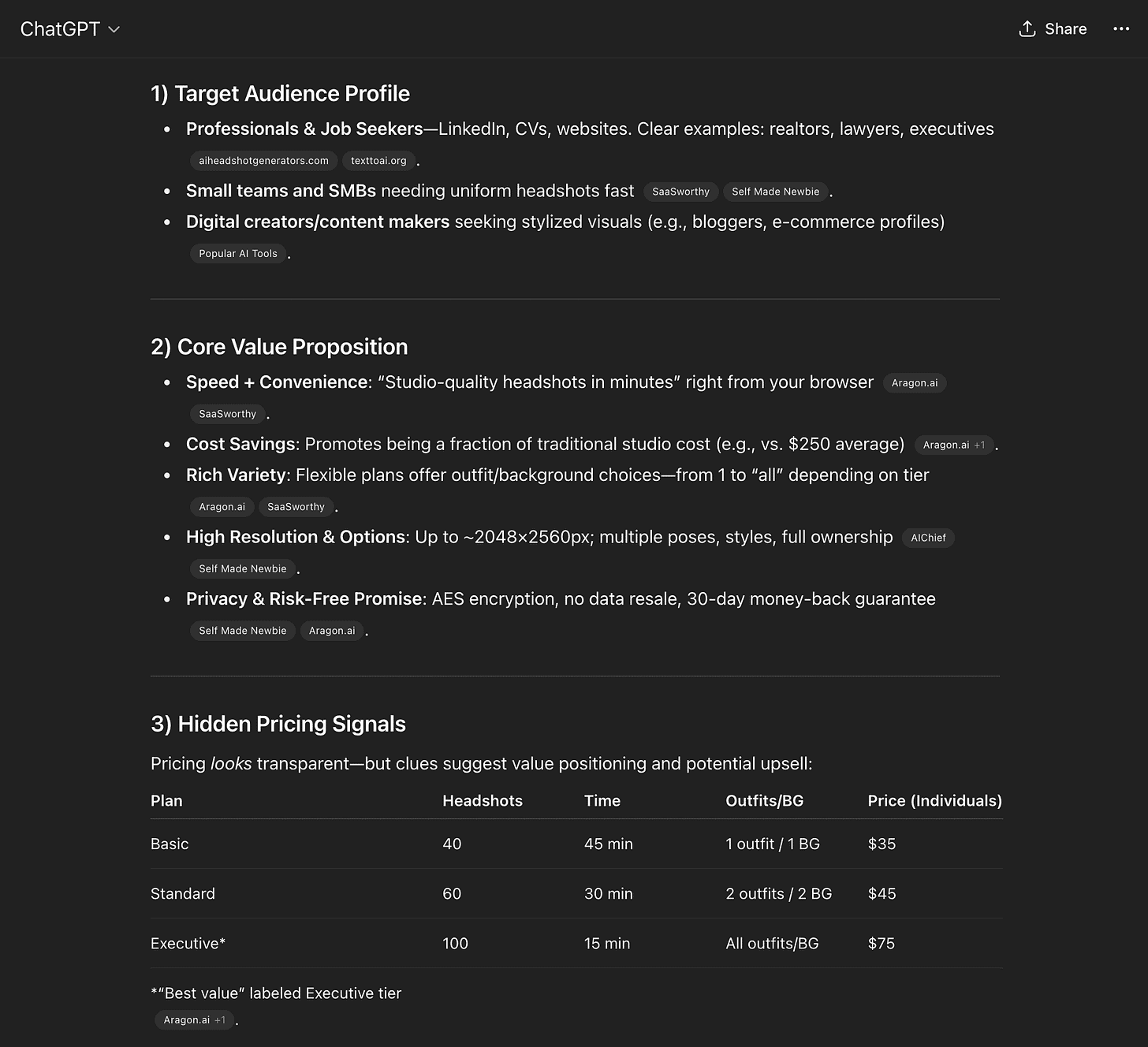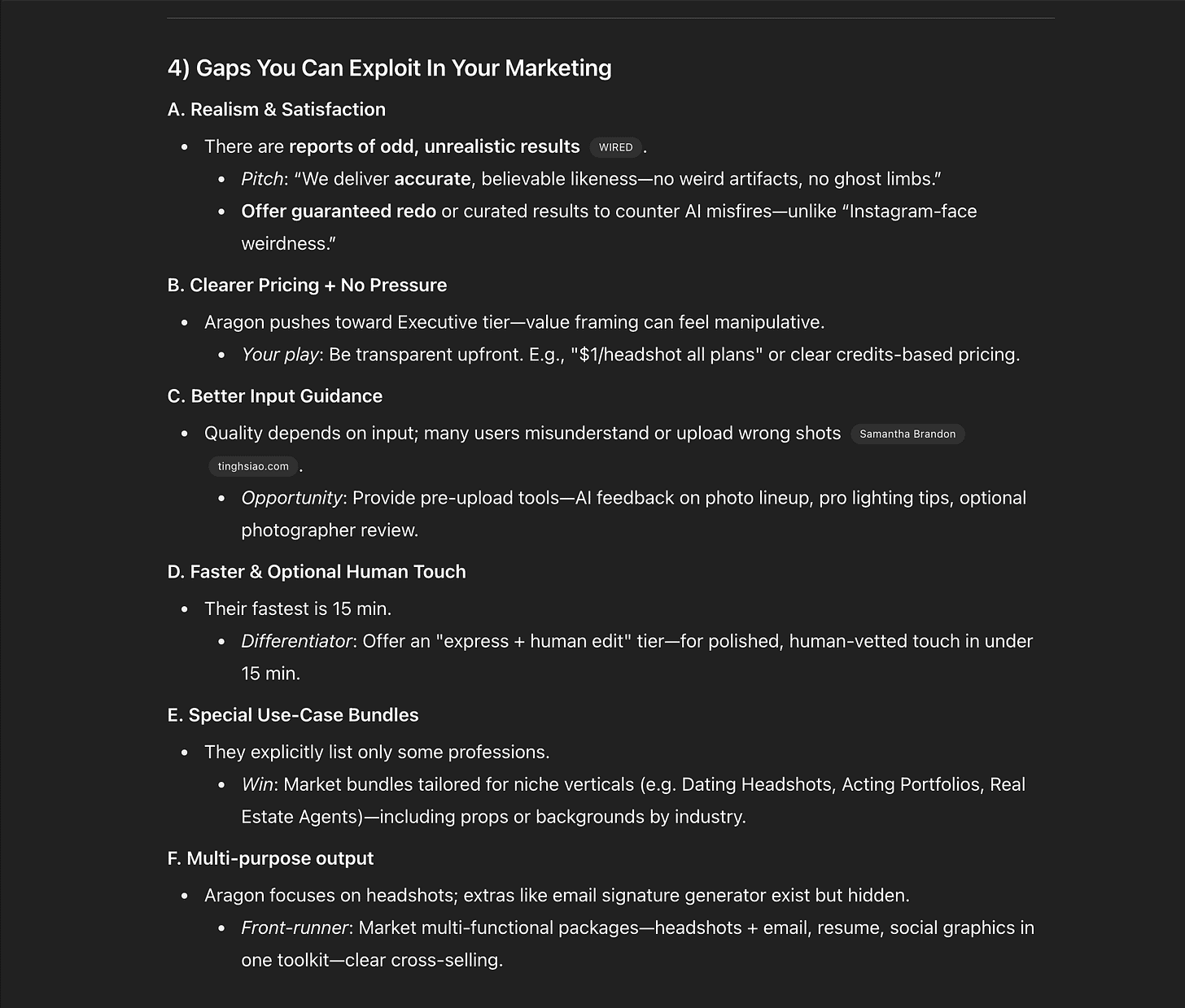I Tested ChatGPT-5 on Solving Real Problems, and It Went Beyond My Expectations
Here, I challenged ChatGPT-5 to solve real problems I deal with every day.
We all know that ChatGPT-5 is here, and I put it through the ultimate test: solving real-world problems. The results? Way beyond what I imagined.
While many creators will just talk about its features, I pushed ChatGPT-5 to the edge, giving it the same tough challenges I deal with every day, from creating “idea-to-launch” blueprints to breaking down competitor strategies.
In short, this post isn’t just about saying how great ChatGPT-5 is. It’s more of a clear, practical look at how I put ChatGPT-5 to the test in real-world situations.
Along with that, I’ll show you the exact prompts I used, the unedited answers it gave, and my honest thoughts. The goal is simple: to give you a step-by-step guide you can use to make this AI work for you in your own life and job.
And the best part? All these experiments were conducted using the free version of ChatGPT-5, so you can try every single one yourself and see its power in action.
With that said, let’s get started.
1. Mastering a Skill
You know, I’ve been a web developer and a content writer for over 5 years now, but I’m actually worried after seeing the insane development in the field of AI.
I don’t even think my skills will be important in the future or that I will make money from them.
So, the only path I have right now is to learn some new skills and make a living out of them.
And I want to try what ChatGPT-5 suggests about how to get started and learn something new.
Here’s the prompt:
You are a senior mentor specializing in AI skill development.
Current level: I know the basics of AI, I’m good at writing prompts, and I’ve used many popular AI tools to get more work done.
Goal: Deepen my expertise & learn more so I can use AI well in real work, solve problems, and find ways to make money with it.
Task: Create a 28-day or a 4 week skill-upgrade roadmap with:
a) Weekly milestones that build progressively from foundational skills to advanced applications.
b) 2–3 curated, high-quality resources per week (courses, papers, videos, or tools) — only the best, with direct links.
c) Weekly practice exercises that lead to portfolio-worthy outcomes.
d) Self-assessment criteria at the end of each week to measure progress.Format the output in a clear table for easy tracking. Take your time, and think harder.
And based on the prompt, here’s the output:
As you can see from the output, ChatGPT gave me a complete, ready-to-use guide on how to learn effectively.
It took around 2 minutes to generate the table, and it made everything super easy — with a clear layout, weekly milestones that build skills step-by-step, curated high-quality resources, practice exercises, and self-assessment criteria that turn it into a real learning plan.
The level of detail and structure was far beyond what I expected.
Also, the resources were great, but I did notice that some of the links were broken.
Lastly, you can even write a similar prompt like this one if you don’t know what skills to learn:
You are a career coach. Role: “paste your job title”.
List:
a) Top 8 skills needed today,
b) My skill gaps based on this resume: <paste resume>,
c) 90-day action plan to close them,
d) 3 free resources for each gap.2. “Idea to Launch” Blueprint
We all have great ideas, right? But the real struggle is execution.
Taking a raw concept and transforming it into a viable business, especially a money-making one, requires a foolproof plan — something many of us lack due to time constraints, knowledge gaps, or simply not knowing where to start.
For me, I wanted to expand my writing services beyond just Substack and Medium, but without a clear roadmap for execution, it felt like an impossible task.
So, I’m going to ask ChatGPT by writing a clear prompt and see whether I can actually get the needed blueprint to grow my AI newsletter further or not.
Here’s the prompt:
You are an expert startup coach and career advisor specializing in AI-based content businesses and audience growth.
Idea: I run a newsletter sharing simple, practical ways to use AI in everyday life and work.
Current platforms: Substack and Medium.
Goal: I want to rapidly grow my audience, expand into multiple income streams, and maximize the newsletter’s value for readers.
Instructions: Generate output in a clear, structured format with short explanations and relevant examples. No BS and generic content please. Think harder and take your time if you want.
Deliverables:
1) Five sustainable revenue models for this niche, with a 1–2 line example for each.
2) Three low-cost MVP approaches to validate audience interest and monetization.
3) A 30-day launch & growth checklist (broken down week-by-week with key actions).
4) Three common mistakes to avoid, with a one-sentence prevention tip for each.
Here’s the output:
Honestly, I expected that it would give me some generic advice and maybe a few common revenue ideas. I certainly didn’t think of a detailed, week-by-week execution plan that I would love to focus on.
What I like the most is that it didn’t recommend I start YouTube, since it’s a tedious process and I may face burnout.
How You Can Use This:
Do you have a business idea in mind? A new service you want to start? A side hustle you want to grow? Use this prompt format. Just replace “AI newsletter” with your own idea and goal. It will save you many hours of thinking, researching, and planning your launch.
I’m literally applying the advice it gave me. It provides the clarity and direction you need to stop dreaming and start doing.
3. Smart Productivity Action Plan by AI
Let’s be honest, we all want to be more productive so we can get more done and make more money.
And for that, we read tons of content, watch multiple YouTube videos, and even follow different productivity hacks.
So I thought, let’s ask ChatGPT to design a productivity system exactly the way you want, and, for sure, customized to your work style, your tools, and your schedule.
Here’s the prompt:
You are a productivity systems architect.
Your goal is to design a personal productivity system that integrates AI tools with my daily workflow for maximum efficiency. Write in a table format.
Deliver:
a) Morning, midday, and end-of-day routines (AI + non-AI)
b) Recommended tools with reasons
c) Daily task prioritization framework
Here’s what it generated:
As you can see, it didn’t give me any generic tips; instead, it outlined specific morning, midday, and end-of-day routines, integrating AI tools with clear reasons to make my day productive.
And it’s way better, to be honest.
How You Can Use This:
Think about your own productivity challenges. It can be anything like managing email, building website projects, or something else.
Then use the above prompt, write your own desired routines and goals, and ChatGPT will help you design a custom productivity blueprint, integrating the latest AI tools based on your day and helping you achieve more.
4. AI Workflow Automation
So far, we have talked about just the basics like how to create a productivity system, master a skill, or get a blueprint to execute like a pro.
And every one of us knows that LLMs can generate code, build your dream websites, and create apps, so I won’t be talking about that here.
Also, as we are more focused on building workflow automation using AI to automate most of our tedious tasks within no time, let’s ask ChatGPT for that.
Here’s the prompt:
You are an AI workflow architect with decades of experience designing advanced automation systems.
Your task is to design an end-to-end automated system to find, summarize, and send the latest AI news to my newsletter subscribers.
Produce:
a) Step-by-step automation workflow (AI + non-AI tools),
b) Recommended tools with reasons,
c) Integration steps,
d) A failover plan if one tool breaks.
Here’s the output:
It even went ahead and gave me the code to create the automation.
Well, I tried it myself by running the code to see whether it would work or not. And well, it worked.
So, this can be really helpful for everyone to create some automated and complex workflows besides using it just as a simple knowledge base.
How You Can Use This:
Think about any repetitive task in your business, job, or personal life that’s taking too much time or is tedious.
Simply use this prompt, swap out “AI news newsletter” with your specific automation need, and detail the desired steps.
That’s all. ChatGPT-5 can help you make and set up smart AI workflows, so you get more done faster and have more time for important work.
5. Deep Dive Summaries for Complex Topics
Imagine trying to understand the main ideas from tons of new research papers published this year.
Reading them one by one means hours, maybe even days, of reading carefully, decoding complex terms, picking out key methods, and pulling out the main results. It’s actually a hard work that takes deep focus, sharp thinking, and a lot of time.
So let’s try GPT-5 to see it’s PhD-level intelligence for this problem.
Here’s the prompt:
You are an academic researcher, and here’s your topic: “Artificial Intelligence”.
Summarize the top 8 papers (published since 2024): for each give 2-sentence summary, main dataset, core result, and one methodological weakness. If you cannot access the internet, say so and list keywords to search.
And here’s the output:
Honestly, I was blown away. As someone who’s read most of these papers, I need to say the output was remarkably accurate, insightful, and up to the mark.
So, compared to earlier LLMs, which often struggled with such detailed analysis or produced generic weaknesses, ChatGPT-5 showed a big improvement in depth, and also, it didn’t hallucinate.
You see, this fundamentally changes how we approach initial research. You no longer need to spend hours going through each research paper just to grasp the info. With this prompt, you get a high-level, yet deeply insightful, overview of multiple complex topics in minutes.
How You Can Use This:
You can apply this exact prompt structure to quickly understand research papers, and even industry trends, or fast-track your learning on any complex subject. This will literally save you hours of detailed reading and analysis, transforming it into minutes.
6. Generating Authentic Stories and Content
Let me tell you, even today, storytelling hasn’t lost its value, and it won’t.
It still makes the difference between content that people scroll past and content that makes them stop, read, and remember.
The funny thing? I still see many creators and writers trying to use LLMs to generate hooks and stories that feel more AI-generated.
The reason? AI is not that smart, and you need to write a better prompt, but I believe the latest version of ChatGPT can generate better stories compared to its previous versions.
To prove my point to you, here’s the prompt I wrote:
You are an expert storytelling copywriter. I will paste some content. Your job is to:
a) Create a short, engaging story or hook at the beginning that relates to the content (could be a real-life scenario, mini-case study, or relatable moment).
b) Smoothly transition into the original content so it reads in a natural flow.
c) Keep the story under 120 words, make it emotionally engaging or curiosity-driven, and relevant to the main point.
d) Maintain the same tone and style as the original content.Content: “Using ChatGPT might be silencing your brain. Or, more precisely, it is making you dumb. What is the proof? Well, a recent MIT study took students writing essays under three conditions: solo brain power, Google only, and ChatGPT assisted. Using EEG brain scans, they measured how deeply each group was engaging with their own thinking process.”.
Here’s what it generated:
Let me be honest — I’ve been using ChatGPT for the past 2 years, and I’ve seen a huge change in how natural its content feels.
The older versions often used uncommon words like “delve”, “realm”, or “embark” — words that instantly made it obvious the text came from AI. It also had some strange formatting habits, like putting “ — ” in the middle of sentences or using “:” in titles for no clear reason.
So by comparison, I can clearly say that the latest model is a big improvement. But note that it still generates generic content if you don’t write a detailed and specific prompt about what you want.
7. Reverse Engineering a Competitor’s Offer
Now, let’s talk about using ChatGPT to study and learn from successful competitors so we can improve our own market strategy.
I’m not saying to blindly copy them, but more about smartly adapting what works. To be more specific, I’m going to show you this by looking at Aragon AI, a well-known AI headshot generator, to see how it’s growing compared to its competitors.
We’ll do this by using a structured prompt with ChatGPT, acting as a virtual market analyst.
Here’s the prompt:
You are a market analyst. I’ll give you a competitor’s landing page URL text.
Provide:
1) Their target audience profile,
2) Core value proposition,
3) Hidden pricing signals,
4) Gaps we can exploit in our own marketing.
And here’s what it generated:
You see, with this prompt, I can get most of the required info about my competitor in no time. The initial sections on target audience, value proposition, and pricing signals are good enough.
But I don’t trust what it wrote in the last section, “Actionable Gaps and Opportunities”. I’ve tried it myself, and to be precise, it is one of the best and most realistic AI headshot generators out there. The other points that are present are completely baseless and have no meaning, so I didn’t like this one.
How You Can Use This:
If you want to quickly understand what your rivals are doing right (or wrong), just ask ChatGPT by providing the URL. It will give you the info you need to know.
Hope you like it.
That’s it — thanks.




